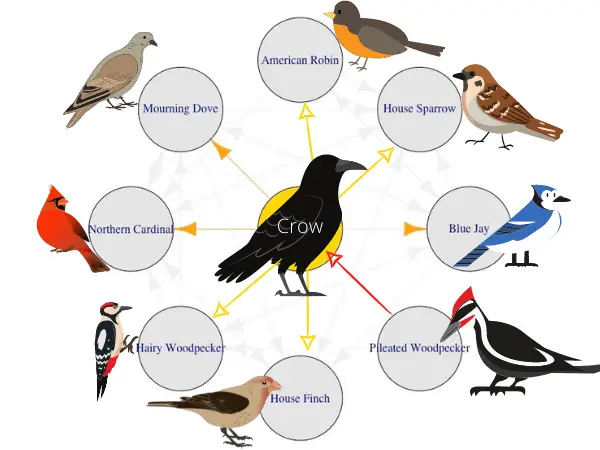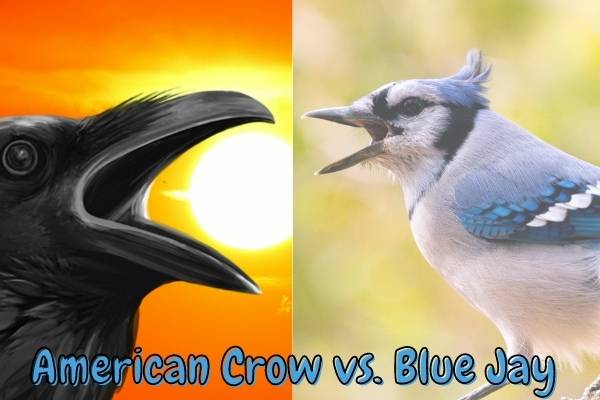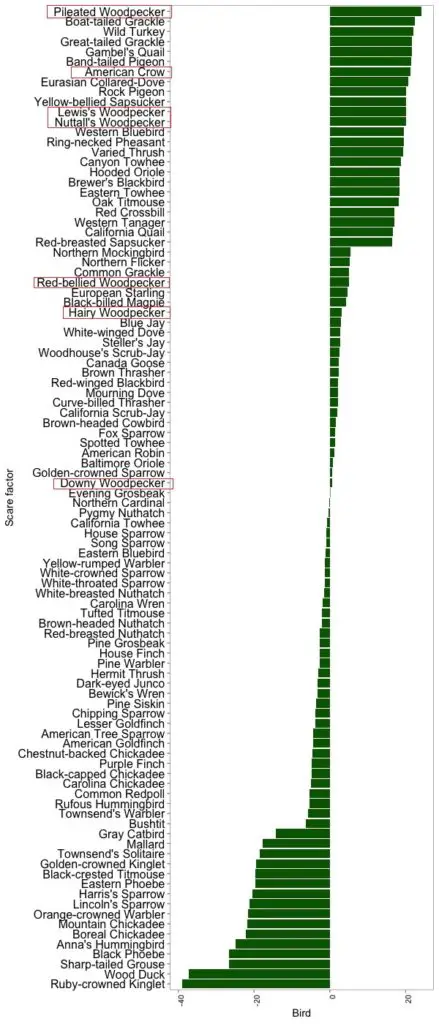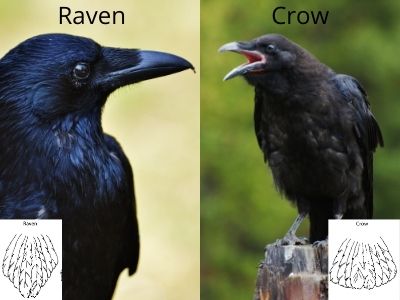Crows are big black birds that you’ll be quite familiar with if you spend time in cities or in your own backyard.
Crows belong to the Corvidae family (their family has a lot of members including jays, ravens, magpies, rooks, and many other types of birds) and I have previously written about where Blue Jays and Cardinals are located in the bird feeder hierarchy.
There are many reasons why you might not enjoy the presence of crows at your bird feeder. They are fairly large and smart birds that can easily scare off most other types of backyard birds from your feeder – and they can sometimes even hunt and eat smaller birds!
Crows are often seen perched in trees or around bird feeders, birdbaths, vehicles, or buildings near human housing. They are omnivores and eat what they can find in your yard. Everything from seeds to smaller birds and tadpoles!
Crows are known to scare away other birds such as robins, sparrows, mourning doves, cardinals, and blue jays. Usually, if a crow flies over another bird, it will scare it away with its intimidating size, loud screech, and bold nature.
Crows always seem to be on the lookout for potential predators, so they are very vigilant when it comes to keeping their families safe and chasing away competition for food.
This kind of competitive behavior is extra prevalent at bird feeders because many different species are attracted to and interact with food sources.

It is important to keep in mind that a bird’s ability to win a fight does not necessarily predict its ability to survive.
However, competition has great ecological, behavioral, and conservation implications for species and these need to be considered when predicting future impacts on these species.
This is why we do research into these behavioral patterns of birds playing out just outside your window – but with potentially great ecological consequences!
I have previously done a similar analysis on the interaction between the Northern Cardinal and the Blue Jay, using the same statistics and data.
In this article, I will discuss the role of crows in the bird feeder dominance hierarchy and show you some new data indicating that they are indeed at the top!
Contents
Do Crows and Magpies Get Along?
Crows and magpies usually make peace with one another, because they live in very similar places, are similarly sized, and are closely related.
The only time that there is usually any conflict between them is when it comes to breeding season or food scarcity.
When crows and magpies are both looking for mates and territories, there might be some problems.
From studies of the bird feeder hierarchy, the American Crow lies quite a bit higher than the Black-billed magpie, indicating that the crow would have an easy time scaring away the magpie and win a fight.
They do, however, rarely fight but they will fight over territories and food sources from time to time, but otherwise, they get along fairly well.
Do Crows and Blue Jays Get Along?
Blue jays can be a problem for crows because they are so very similar in nature. Not only are they both incredibly intelligent, but they have similar temperaments.
They both belong to the same family of crow-birds, so they are quite similar in many ways.
However, crows don’t tend to interact with blue jays much at all, except for when they are searching for food at bird feeders.
For most of the year, crows and blue jays keep different schedules. It is only for a little while that they are in close enough proximity to one another to be able to interact with each other at all.

How smart are blue jays in comparison to crows?
Crows are generally considered smarter due to their larger brain and more complex behavior, but blue jays are relativity smart when considering their size.
Both crows and blue jays are part of the corvid (Corvidae) family of highly intelligent crow-like birds, which also include magpies, ravens, and other jays (e.g. Stellars Jay).
The corvids are known for their high intelligence so all birds within that family are more intelligent than the average bird!
Can Blue Jays Scare Away Crows?
Blue Jays and crows are in the same family, but blue jays are significantly smaller and therefore scared of crows.
If they meet at the bird feeder, crows have no problem fending off intruding blue jays, but may not necessarily do so.
The only time that blue jays and crows may work together is during the nesting season. Other than that, they are always rivals. They will chase each other off whenever they have the chance, and use aggressive methods to get rid of one another.
Do Crows Scare Away Cardinals?
Cardinals are almost always scared of crows and will not get along with them most of the time.
The only reason crows would occasionally be scared of cardinals is because they live so close to one another, and the cardinal is focused on fighting off competition for food or territory.
Cardinals can be very aggressive despite their small size, and they will often raise their crest in anger and it is not uncommon to see them attack their own mirror image when standing close to windows!
The cardinal is so small that crows usually don’t bother with them and move on, but crows are obviously much bigger than cardinals so they would always be able to scare them away if really needed!
Do Crows Scare Away Woodpeckers?
Most woodpeckers, yes, but not the largest one – the pileated woodpecker!

Whereas smaller woodpeckers like the downy woodpecker, the hairy woodpecker, or the red-bellied woodpecker are lower in the bird feeder hierarchy than the American crow, there is indeed one woodpecker that can compete with crows!
Indeed, the large and aggressive pileated woodpecker isn’t very afraid of crows! But the crows are pretty scared of them.
In fact, the pileated woodpecker is right at the top of the bird feeder hierarchy, making it the most “scary” of all common backyard birds in North America!
The pileated woodpecker is a member of the woodpecker family and is also nicknamed the “red-headed woodpecker”. It is a large bird about the size of a crow (about 12 to 14 inches long—about 38 to 35 centimeters).

However, it can be easily distinguished from the crow most notably by its red crest. This bird weighs between 5-14 oz. (300 to 400 grams) and has a wingspan of about 28 inches, which sets it magnitudes apart from the smaller e.g. downy woodpeckers.
Its plumage is black and white with a red crest that is noticeable even at great distances. The head, neck, back, and wings are black with white stripes towards the ends of the feathers. It has yellow skin around its eyes and pale pink coloring on its bill. The throat, belly, and under tail are all black.
If a crow tries to make its way towards a pileated woodpecker’s nest or territory, it won’t last very long before it gets driven off!
This is also the case for the bird feeder!
Do Crows and Doves Get Along?
Crows and doves don’t have much of a reason to interact with one another, since they have very little in common. However, they do meet occasionally at the bird feeder.
Crows and doves like the mourning dove don’t get along well if they meet at the feeder, and will often fight with each other in order to protect their food and territory.
It is also possible that crows will ignore doves as they see them as benign and not much of a threat, but there is no evidence about this.
The main thing you should understand is that crows are far above doves e.g. the mourning dove in the bird feeder hierarchy.
Are Crows and Owls Enemies?
Crows are naturally afraid of most owls so they have problems getting along because, although rarely, crows may be preyed upon by larger owls.
Owls can eat crow’s chicks as well as the crow, and crows will want to get rid of owls so they don’t have to worry about this. But a crow cannot take on an owl on its own.
This is why often team up to scare away larger birds crows.
What do Crows Think of Sea Gulls?
Crows have a pretty interesting relationship with seagulls. Even though crows are afraid of seagulls, they will still try to get rid of them anyways.
Although crows will instantly try to chase off any other seagulls in the area, they seem to be more afraid of them than anything else.
As seagulls are not frequent visitors of bird feeders, there is no good data on their interaction with other feeder birds including crows.
Are Crows and Hawks Natural Enemies?
Crows and hawks also have a very natural conflict between them, because they are indeed natural enemies.
However, most often hawks are not present in the urban environment or near bird feeders where modern crows spend most of their time.
Crows will view hawks as a threat, and they will do whatever it takes to get rid of them. Hawks will consider smaller crows as their food, so crows have evolved to hide from hawks and protect their young.
A group of crows will get together to attack a hawk if the opportunity arises, and they will not hesitate to do so.
Do Crows and Ravens Get Along Well?
Crows and ravens do not usually get along, and they will also fight each other in a variety of ways. Crows have been known to try mob ravens when they get the chance, or even work together with other birds to take them down.
Ravens are very closely related to crows, but are bigger and stronger than crows. Therefore they will usually have the upper hand in a fight!

Ravens are carnivores and they may try to eat young crows whenever they get the chance.
Ravens are dangerous for crows because they often win fights, which cause crows to become fearful of them.
Even if two crows get into a fight with one raven, the odds are very much against the two crows. That is why you should be able to see why crows and ravens are natural enemies.
What Birds Are Crows Afraid Of?
Crows are not really afraid of many other birds except for larger birds such as hawks, eagles and owls, but some backyard birds like the Pileated woodpecker, Boat-tailed Grackle and Wild Turkey will also scare away crows more often than not!

This is because they have the upper hand in terms of size, speed, and aggression. If a hawk or owl comes around looking for food, crows won’t take too kindly to it. They will either try to goad it into leaving by making sounds and fluffing up or will just move on to a different location.
The thing that crows are most afraid of is likely larger mammals like humans that, if they stay around, you, could get them killed.
Conclusion
Crows will often fight with other birds in order to defend their territory or get rid of the competition.
The types of birds that crows are most afraid of are birds of prey because they are too large for crows to fight off.
Crows and hawks can often live near one another without any issues, but at times they will end up in a conflict and attack each other.
Backyard birds like crows and blue jays will also fight with one another, but it is usually not very serious unless they are defending their mates or nests.
The truth is that most birds are actually more likely to fight other birds within the same species, rather than birds of another species!
They may even get together with other species sometimes to scare off predators such as raptors, but this is relatively rare.
If you are interested in knowing more about how birds interact with each other at the bird feeder, check out my articles on Blue Jays and Cardinals and whether the robin is considered to rank high or low in the bird feeder hierarchy!
Backyard birds in other states
Are you interested in how the backyard birds in your state compare to other states?
Then check out my other blog posts below:
- Backyard birds of Alabama
- Backyard birds of Colorado
- Backyard birds of Delaware
- Backyard birds of Georgia
- Backyard birds of Hawaii
- Backyard birds of Illinois
- Backyard birds of Iowa
- Backyard birds of Kentucky
- Backyard birds of Louisiana
- Backyard birds of Maryland
- Backyard birds of Massachusetts
- Backyard birds of Missouri
- Backyard birds of Nebraska
- Backyard birds of New York
- Backyard birds of North Carolina
- Backyard birds of Oklahoma
- Backyard birds of Rhode Island
- Backyard birds of South Carolina
- Backyard birds of Tennessee
- Backyard birds of Texas
- Backyard birds of Virginia
- Backyard birds of West Virginia
- Backyard birds of Wisconsin
- Backyard birds of Wyoming
And in Canada:
- Backyard birds of Ontario
- Backyard birds of Prince Edward Island
- Backyard birds of Saskatchewan
- Backyard birds of Quebec
Not on the list? Check out the rest of my posts on backyard birds here!
Maybe you would like to know if the Blue Jay or Cardinal dominates in the bird feeder hierarchy or how birds such as seagulls sleep at night? Or why mourning doves poop so much and whether most birds can poop and fly at the same time!
A lightweight handy pair of binoculars is a must for your backyard bird watching! Check out my recent post on the best small lightweight binoculars for birdwatching etc.
My Favorite Backyard Birding Gear:
- Photographs and identifies birds coming to your bird feeder!
- Notifies you via the app whenever a bird stops by!
- Excellent resolution and battery performance with the 6MP image sensor.
- Connect from anywhere with internet access (watch birds even when you are not at home!)
- Count the birds visiting your feeder and contribute to projects such as FeederWatch!
If you are interested in posters and other wall arts etc. with drawings of all the backyard birds you have just read about, check out my portfolio over at Redbubble:
Acknowledgements
I want to thank the Cornell Lab of Ornithology at Cornell University and the Birds Canada organization as well as all the citizens who have been involved in the FeederWatch project for providing the data of this article. The data I have used to generate the prevalence numbers for this article is provided by the FeederWatch project. The FeederWatch project is an initiative by The Cornell Lab of Ornithology at Cornell University and the Birds Canada organization. The data is collected through an immense crowdsourced citizen science program, where citizens of the United States and Canada are invited to count birds at their bird feeders, identify the species, and report back to the scientists at Cornell University. The birds are counted from November to April and always in two consecutive days including only one area with a bird feeder, typically a piece of the backyard, observed from one vantage point. The two-day watch is then repeated throughout the season. The data is collected each year and is freely available to the public at https://feederwatch.org/.
References
American Museum of Natural History Birds of North America. DK; Revised edition (September 6, 2016). ISBN: 978-1465443991
National Geographic Backyard Guide to the Birds of North America, 2nd Edition. National Geographic; 2nd edition (October 15, 2019)
Birds of North America. National Audubon Society. (Knopf April 6, 2021). ISBN: 978-0525655671







